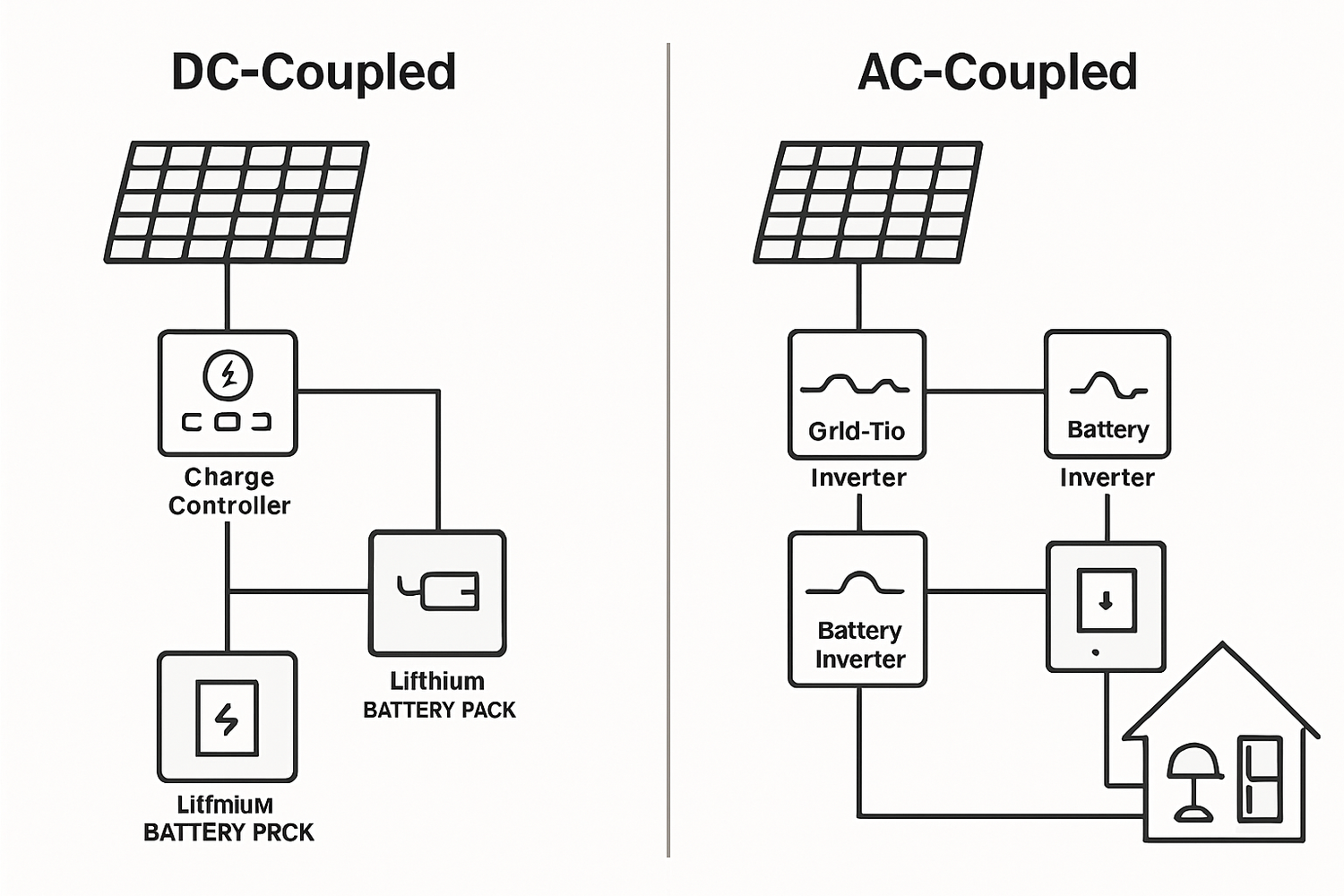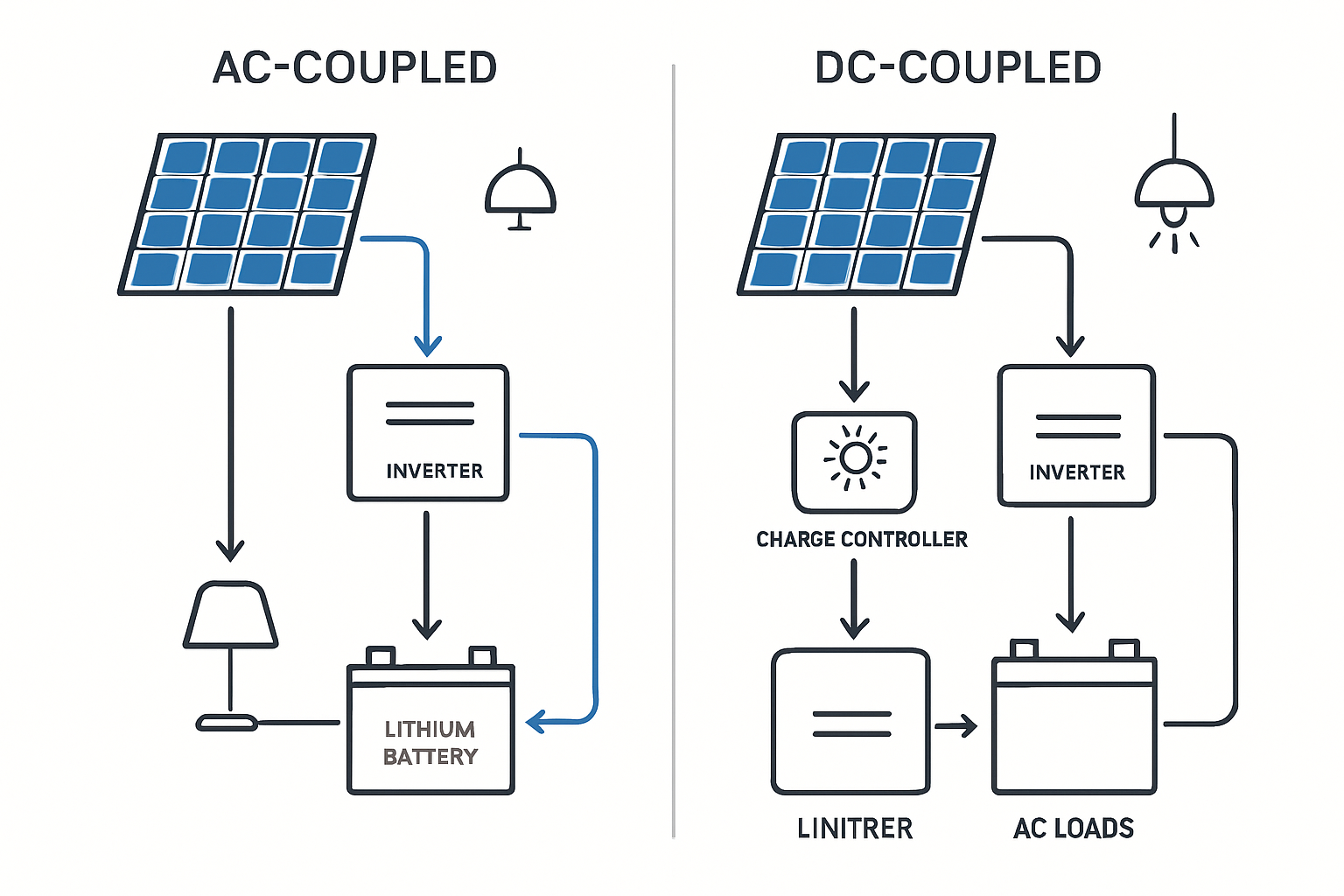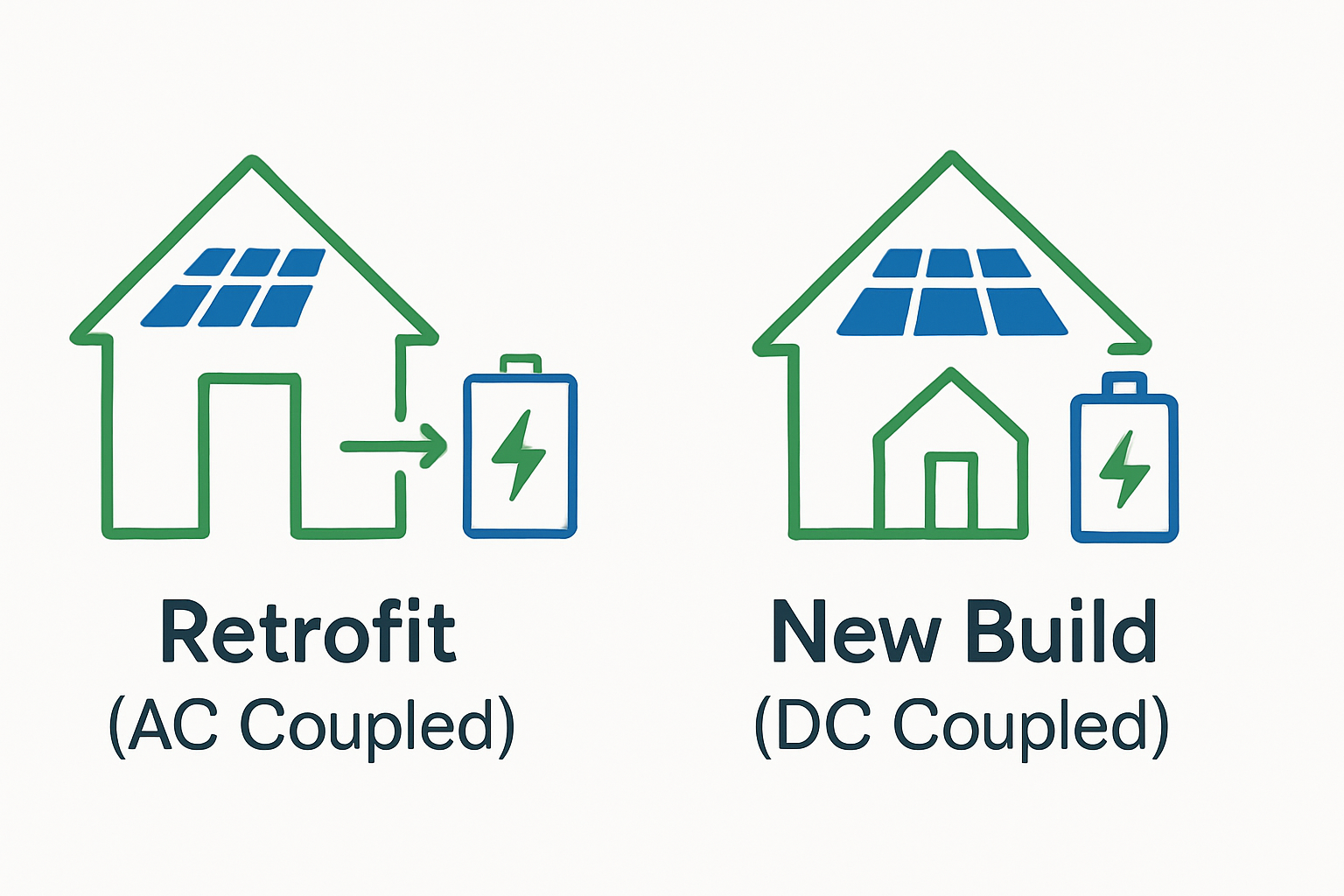An inverter is the heart of any solar and storage system, converting the direct current (DC) power from your batteries into alternating current (AC) to power your property. When using high-performance lithium iron phosphate (LiFePO4) batteries, selecting the correct inverter is not just a recommendation—it's essential for safety, efficiency, and longevity. The right pairing ensures your entire system works in harmony, delivering reliable power when you need it.
Understanding the Core Architectures: AC vs. DC Coupling
The way an inverter integrates with your solar panels and lithium battery pack defines the system's architecture. The two primary configurations are AC-coupled and DC-coupled systems, each with distinct characteristics that make them suitable for different applications.
What is a DC-Coupled System?
In a DC-coupled architecture, solar panels and the lithium battery pack are connected on the same DC side of a single, intelligent hybrid inverter. Energy flows directly from the solar panels to charge the battery, without being converted to AC first. The hybrid inverter then converts the DC power from either the panels or the battery into AC power for your home's appliances.
- Energy Path: Solar Panels (DC) → Charge Controller → Battery (DC) → Hybrid Inverter → AC Loads
- Best For: New solar and storage installations, off-grid systems, and maximizing energy efficiency.
What is an AC-Coupled System?
An AC-coupled system involves two separate inverters: a solar inverter for the panels and a battery inverter for the storage system. The solar panels generate DC power, which is immediately converted to AC by the solar inverter for use in the home. To charge the battery, this AC power is then converted back to DC by a second battery inverter.
- Energy Path: Solar Panels (DC) → Solar Inverter (AC) → Main Panel → Battery Inverter (DC) → Battery (DC)
- Best For: Retrofitting a battery system into an existing grid-tied solar installation.
Key Architectural Differences
The choice between these two setups impacts efficiency, cost, and installation complexity. DC-coupled systems are generally more efficient because the power undergoes fewer conversions. Studies have shown that DC-coupling can result in a higher overall benefit-to-cost ratio due to reduced conversion losses. AC-coupled systems, while slightly less efficient due to multiple DC-to-AC-to-DC conversions, offer greater flexibility, especially for existing solar owners.
| Feature | DC-Coupled System | AC-Coupled System |
|---|---|---|
| Efficiency | Higher (typically 95-98%) due to fewer energy conversions. | Slightly lower (typically 90-94%) due to multiple conversions. |
| Primary Inverter | One hybrid inverter manages panels, battery, and grid. | Two inverters: one for solar and one for the battery. |
| Installation | Ideal for new, integrated systems. Simpler component count. | Easier to add to existing solar panel systems. |
| Use Case | New installations, off-grid homes, maximizing efficiency. | Retrofitting storage to an existing solar setup. |
Critical Factors for Your Inverter Selection Guide
Beyond the system architecture, several technical specifications are vital for a successful pairing with your lithium battery pack. Overlooking these details can lead to poor performance or even damage your equipment.
Lithium Battery Compatibility and BMS Communication
Modern lithium batteries, like LiFePO4 models, feature an integrated Battery Management System (BMS). The BMS is the battery's brain, protecting it from overcharging, deep discharging, and extreme temperatures. For optimal performance, the inverter must be able to communicate directly with the BMS. This 'closed-loop communication' allows the inverter to receive real-time data on the battery's state of charge (SoC) and health, adjusting charging and discharging parameters dynamically. Always check the manufacturer's compatibility list to ensure the inverter and battery can 'speak' the same language, often using protocols like CAN or RS485.
Sizing the Inverter for Your Loads
Properly sizing your inverter is a crucial step. You need to calculate both your continuous load and your peak (or surge) load.
- Continuous Power Rating: This is the total wattage of all appliances you expect to run simultaneously. It's wise to add a 25% buffer to this number for safety and future expansion.
- Surge Power Rating: Many appliances, such as refrigerators or pumps, require a large burst of power to start up. The inverter must have a surge rating high enough to handle these initial peaks without shutting down.
Efficiency and Performance Metrics
Inverter efficiency ratings indicate how much DC power is successfully converted to AC power. While top-tier inverters boast efficiencies over 95%, it's also important to consider round-trip efficiency in a storage system. This metric measures the total energy lost during the process of charging and later discharging the battery. As detailed in this reference on solar storage performance, even small percentage differences in efficiency can accumulate into significant energy savings over the system's lifespan. DC-coupled systems often have a higher round-trip efficiency because energy is stored more directly.
Making the Right Choice for Your Application
The ideal inverter depends entirely on your specific situation and goals. The growing interest in pairing storage with solar, as noted in reports from the U.S. Energy Information Administration (EIA), underscores the need for smart system design.
For New Solar Installations
If you are installing a complete solar and battery system from scratch, a DC-coupled setup with a hybrid inverter is often the superior choice. It offers higher efficiency, a more streamlined installation with fewer components, and is purpose-built for integrated energy management. A hybrid inverter acts as a central hub, intelligently directing power between your panels, battery, and home loads for maximum self-consumption.
For Adding Storage to an Existing System
If you already have a functional grid-tied solar panel system, an AC-coupled inverter is the most practical and cost-effective solution for adding a lithium battery pack. This approach allows you to leave your existing solar inverter in place, adding the battery and its dedicated inverter with minimal disruption to your current setup.
A Note on Off-Grid Systems
For off-grid applications, reliability and efficiency are paramount. DC-coupled systems are strongly favored here. Their higher efficiency means less wasted energy, which is critical when you rely entirely on what you can generate and store. The integrated nature of a hybrid inverter also provides robust and simplified management of your limited power resources.
Your Path to Energy Independence
Choosing the right inverter is a foundational step in building a resilient and efficient energy storage system. By understanding the differences between AC and DC coupling and carefully matching the inverter's specifications to your lithium battery and power needs, you create a system that is safe, reliable, and optimized for performance. This decision empowers you to take control of your energy, reduce reliance on the grid, and move closer to true energy independence.
Disclaimer: This article is for informational purposes only and does not constitute financial or legal advice. Please consult with a qualified professional for system design and installation.
Frequently Asked Questions
What is the main difference between an AC-coupled and a DC-coupled inverter system?
The primary difference lies in how solar energy is routed and stored. In a DC-coupled system, solar panels and batteries share a single hybrid inverter on the DC side, offering higher efficiency. In an AC-coupled system, solar panels have their own inverter, and the battery system has a separate inverter, making it ideal for retrofitting existing solar setups.
Why is BMS communication so important for a lithium battery inverter?
BMS (Battery Management System) communication allows the inverter and lithium battery to work together intelligently. The BMS monitors the battery's health, voltage, and temperature, sending this data to the inverter. The inverter then uses this information to optimize charging and discharging, which enhances safety, extends the battery's lifespan, and improves overall system performance.
Can I use any inverter with a LiFePO4 battery?
No, it is not recommended. You should use an inverter that is specifically designed for or compatible with lithium-ion (Li-ion) or LiFePO4 batteries. These inverters have the correct charging algorithms and communication protocols to work with the battery's BMS. Using an incompatible inverter, such as one designed only for lead-acid batteries, can lead to inefficient charging, potential damage, and safety risks.





Leave a comment
All comments are moderated before being published.
This site is protected by hCaptcha and the hCaptcha Privacy Policy and Terms of Service apply.